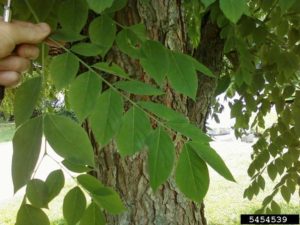
Credit: Jason Sharman, Vitalitree, Bugwood.org
Scientific name: Gymnocladus dioicus
Native to: Hardwood region west of the Appalachians (includes Wisconsin)
Mature Height*: 50’-70’
Spread*: 30’-50’
Form: large upright oval to rounded tree, has irregular course outline in winter
Growth Rate*: slow to medium
Foliage: very large bipinnately compound leaves 17”-36”, individual leaflets are 1”-2” long and pointed
Fall color: yellow
Flowers: whitish, clustered, appearing May-June
Fruit: female trees produce chunky, dark brown flattened pods, 2”-10” long and 1½” wide, September-winter
Bark: dark with unique scaly ridges
Site Requirements: prefers fertile loam soil with ample moisture, but has been known to grow in heavier soils; tolerates alkaline soil and urban environments; salt tolerant; full sun; transplant B&B in spring
Hardiness zone: 3b
Insect & Disease Problems: no serious problems
Suggested Applications: street tree, wildland, native parks
Limitations: fruit is sometimes viewed as a nuisance (female trees only; male cultivars are available)
Comments: initially it can be hard to win over the public’s approval, because of its ugly duckling and sparse appearance when young; with age the tree becomes oval to round and broadens; the mature form, bark, and pods add nice winter interest.
Cultivars: ‘Espresso,’ Prairie TitanTM, and ‘Stately Manor’ (all three are male and therefore seedless)
Fun fact: Settlers used to roast the seeds, grind them and use them as a substitute for coffee beans. (Seeds are poisonous if eaten raw.)
*Urban tree size and growth rate vary considerably and are strongly controlled by site conditions.
(This is an updated version of an article written by DNR Urban Forestry Coordinator Don Kissinger for the urban forestry newsletter in 1994. Don thanked the city foresters of Stevens Point, Green Bay, Fond du Lac, Wauwatosa, and Waukesha for the information.)
#NASF100
